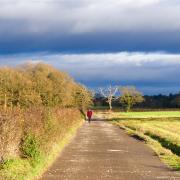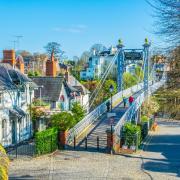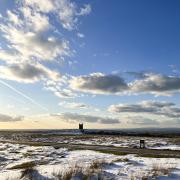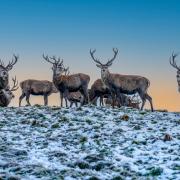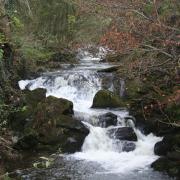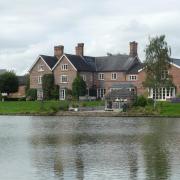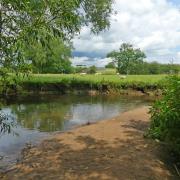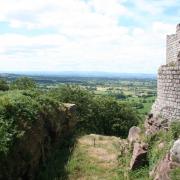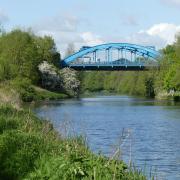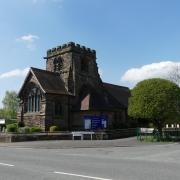This walk in south Cheshire takes in handsome cottages, charming lakes and wide views from a low hill.

Many of Cheshire’s meres are off-limits, sequestered within private estates or curtained by trees and unvisited by rights of way. Quoisley Big and Little Meres, in the far south of the county, fit this pattern, to the detriment of the would-be visitor but to the benefit of their undisturbed wildlife.
These shallow glacial lakes, lily-clad and fringed with alder and willow, are important wildlife sanctuaries that form a key element of English Nature’s Meres and Mosses Natural Area.
Although there is no public access to the lakes or the protective SSSI that surrounds them, they can be glimpsed from the adjoining lanes and overlooked distantly from Wirswall Hill on this route.
Marbury Big Mere, on the other hand, has no such inhibitions.

Overlooked by the splendid red sandstone church of St Michael and frequented by fishermen, it has a popular public footpath along its eastern shore, which forms the grand finale of this short walk.
Each May (pandemics excepted) the fields between village and mere are the setting for Marbury Merry Days, a traditional two-day country fair featuring military re-enactments, dog shows, classic cars, morris dancing and more.
Marbury itself is a compact, neighbourly village centred around church and pub, with a cluster of fine half-timbered buildings.

Dog-owners should note that sheep are likely to be encountered over much of the circuit. Low-lying parts of the walk around the mere are likely to be squelchy underfoot after all but the driest weather, so wear appropriate footwear.
There are numerous stiles en route, and a significant ascent to the halfway point on Wirswall Hill. Locals apparently know this as Killcow Hill, but in truth the climb is gradual and the elevation moderate – a mere stroll, indeed.
1. From the Swan, facing the black-and-white cottages, turn right and walk up the main village street, passing the entrance to the church (visited later) on the left.
At the junction with School Lane, turn left on a signposted footpath and bear half-right across the field. Climb a stile beside a gate and continue in a similar direction to a footbridge above a farm gate.
Turn left through a gate and follow a track across low-lying rushy meadows, crossing a farm bridge over a dyke partway across. Beyond a second bridge, turn right to a stile in the fence on the left. Cross a field of crops to reach another stile into Wirswall Lane.
2. Turn left and follow the lane for half a mile, with glimpses of the Quoisley Meres on your right. Just by the sign for Wirswall, after a house on the left and before a farm on the right, turn left into a driveway and then climb a stile into a field on the right.
Walk left of a tree and head uphill to a stile by a gate (initially hidden by the curve of the land). Continue uphill, pass another gateway concealed in a dip.
At the top of the field the path meets Wirswall Lane again. This marks the turning point of the route, so there’s no need to cross the stile unless you wish to rest at a picnic table and bench beside the quiet lane.
3. When ready to continue, from an adjacent stile walk down the right-hand side of the field you’ve just climbed. Despite the relatively low elevation, the views from Wirswall Hill over much of Cheshire are impressive, with the wooded ridge of the Peckforton Hills to your left and the heights of the Cheshire Peak District a hazy presence to your right.

Climb a stile on the right and descend the sheep pasture beyond, aim towards a distant wood. At the bottom of the slope is a stile and adjoining gate; beyond it, continue with woodland on your right to another gate and stile. Walk down a dry valley to a gate by the edge of a wood.
4. The next field seems to be invariably boggy underfoot, and you may need to deviate onto higher ground to the left, below the house, but the right of way runs close to the woodland edge and your ultimate aim is to reach the far right-hand corner, where a gate and stile leads into the lakeside footpath.
This too may be muddy, but the views over the mere to the church are ample compensation. Follow the path ahead with the mere on your left past a series of fishing stations. A gate leads into fields, through which you continue along the lakeside. Beyond a stile, leave the water’s edge.
The public footpath leads out to the road (turn left to return to the Swan) but a well-used if unofficial route bears left above a hedged stream up to the church; from the churchyard, exit via the lychgate and follow the drive back to the centre of the village.
Compass Points
Area of walk: Marbury near Whitchurch (beware confusion with the country park of the same name near Northwich)
Start point: Swan at Marbury SY13 4LS
Distance: 2½ miles
Time to allow: 1½ to 2 hours
Map: OS Explorer 257 Crewe & Nantwich
Refreshments: The Swan, Wrenbury Road, Marbury, SY13 4LS, swanatmarbury.co.uk 01948 522 860

A traveller's rest
The Swan at Marbury
The Swan Inn was voted New Pub of the Year in the 2020 edition of the Good Pub Guide, following a lengthy closure for refurbishment two years earlier during which the kitchens were extended, a garden room added and the car parking area surfaced and expanded (though, as with most pubs, space is still at a premium for paying customers and non-patrons are politely requested to park thoughtfully elsewhere).
There has been a pub called the Swan on this site since the 18th century, but the current building was built in the 19th century and the older parts of the interior have a comfortable, Edwardian feel.
A few centuries older, at the rear is a glorious half-timbered and Grade-II-listed barn, currently used for offices, staff changing and storage; the patio area between pub and barn is dotted with tables shaded by large parasols, seating around 60 and ideal for al fresco dining.
The mid-priced menu includes a reasonable selection of vegetarian, vegan and gluten-free dishes and, a sensible innovation, indicates where other options can be tweaked on request to suit dietary preferences.
Many of the recipes are enhanced by the addition of herbs gathered from the pub’s own garden.
The pub’s website has suggestions for other local walks. The Swan is open seven days a week and, as you would expect in a popular walking area, is dog-friendly, though landlord Tom Morgan-Wynne advises dining customers intent on bringing their dogs with them to mention it when booking.
Your canine companion may be offered a biscuit on arrival, and there is a barrel of drinking water provided for them, playfully labelled 'Paws Light'.




